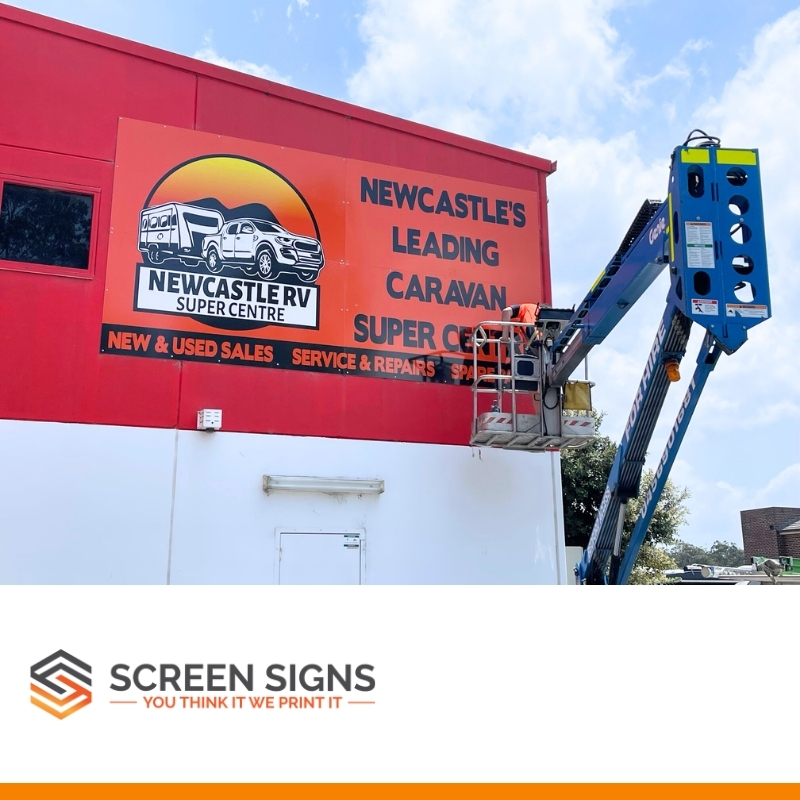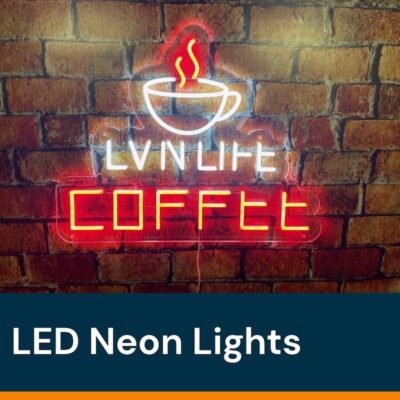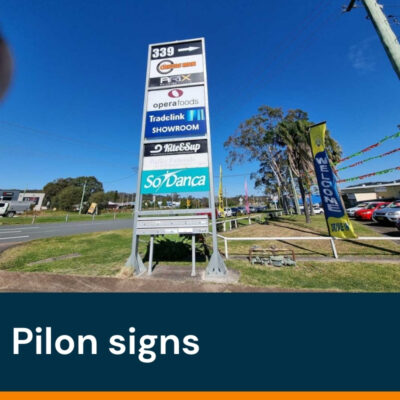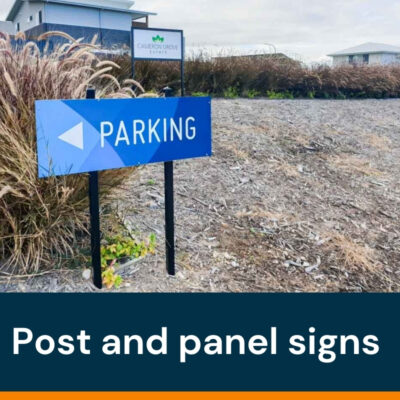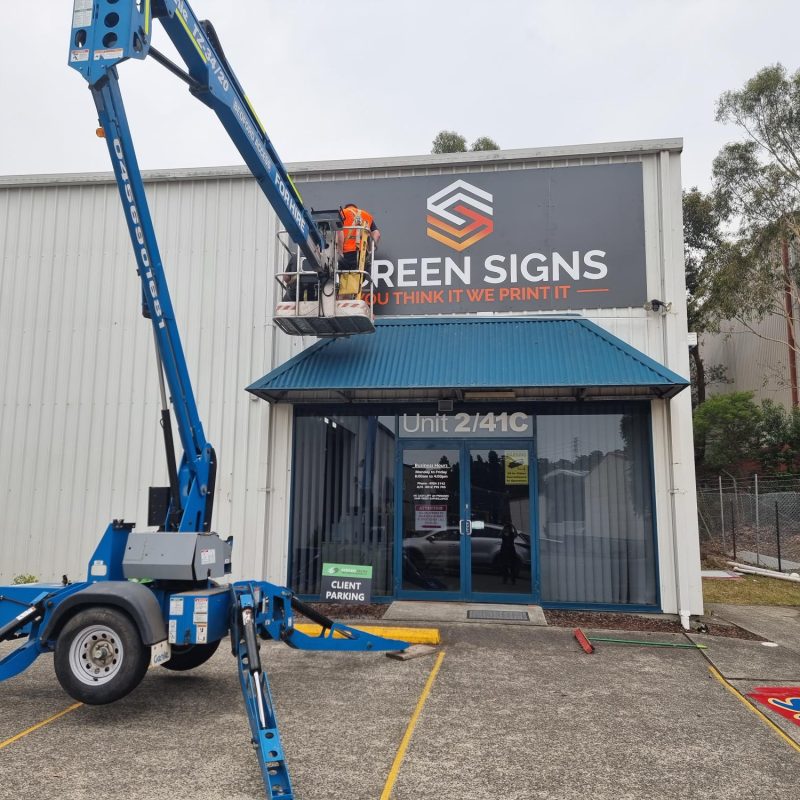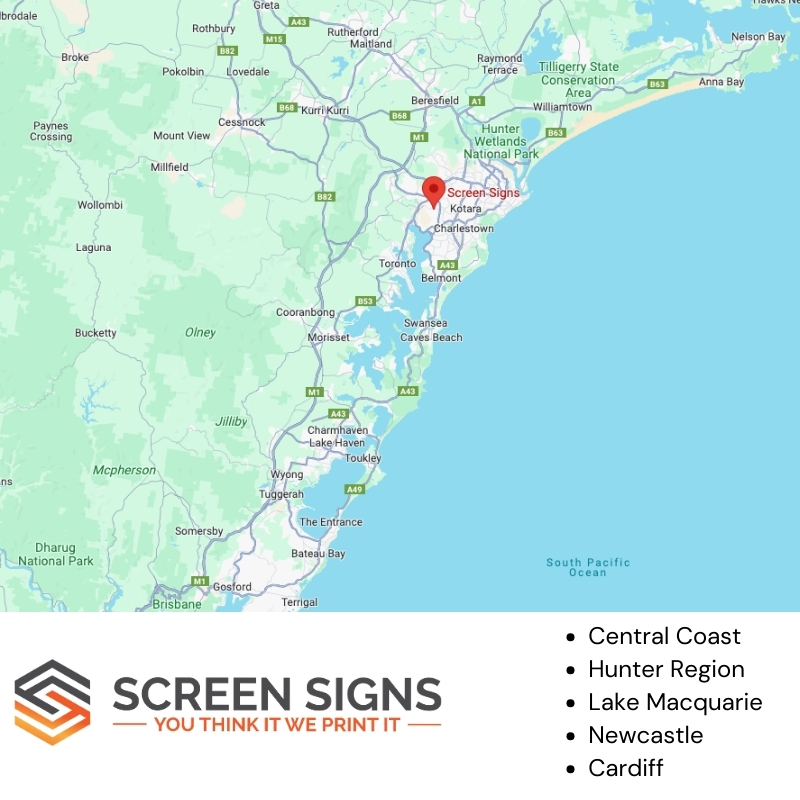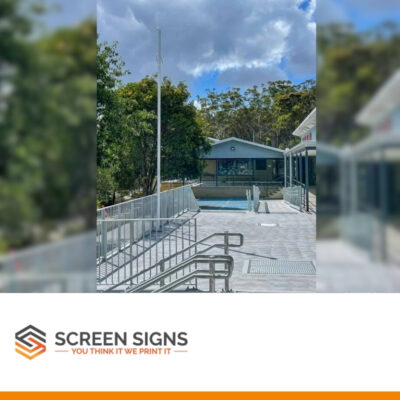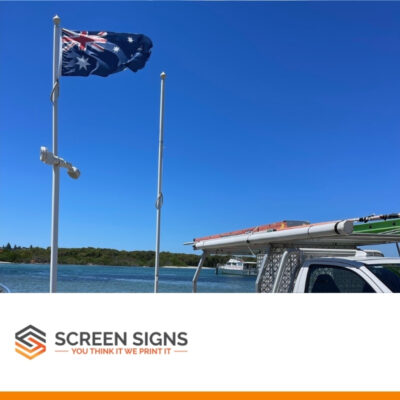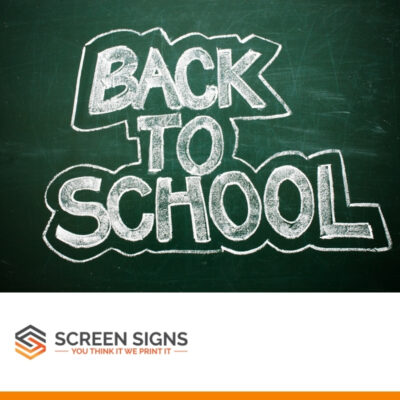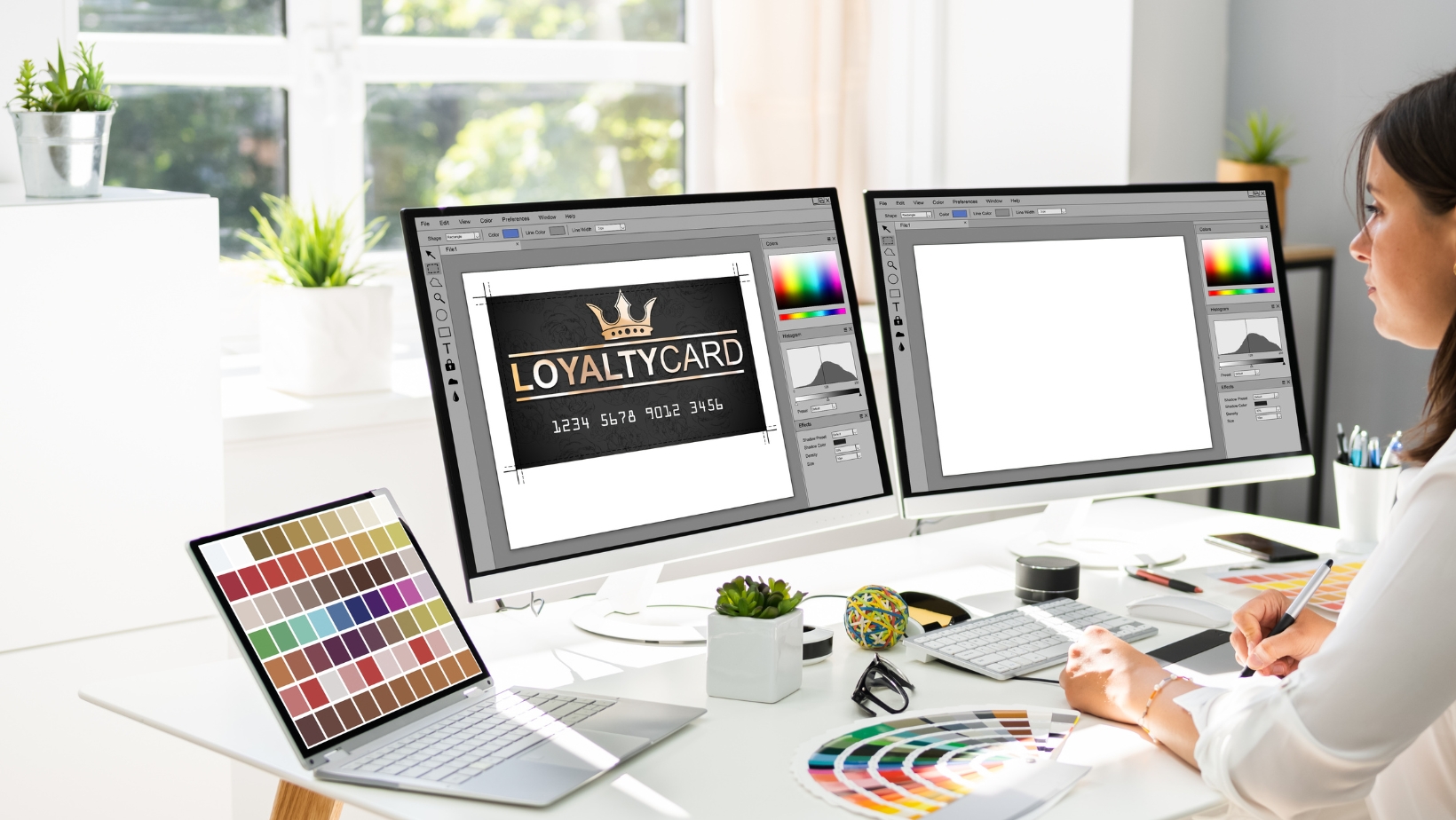Building signage explained
- Building signs can be installed indoors or outdoors
- Custom designed building signs can be made by a sign writer
- Our sign shop sells all types of building signage
- We can design, print & install building signage.
Our sign shop in Cardiff on the Central Coast of NSW can help anyone create new building signage as the fastest way for people to ‘see’ your location with great signs that are visible from all angles on a pilon, wall, awning, fascia, fence, lightbox or window.
Building signage plays a crucial role in branding and marketing for businesses and organisations in the Newcastle region. Typically our sign writing company refers to it as the signs mounted on buildings, either externally or internally, to promote, identify, or provide information about the business or its services at that location.
Building signage comes in various forms, such as facade signs, monument signs, digital displays, and window lettering. These signs are designed to capture the attention of passersby and effectively communicate the brand’s message. Our sign writing company can custom design, manufacture and install any type of building sign that you may require.
What is building signage?
The evolution of building signage has seen a shift from traditional, static signs to more dynamic, digital solutions. Modern building signage often incorporates advanced technologies like LED displays, interactive elements, and these days even sustainable materials. The design and placement of these signs are influenced by factors like local zoning laws, branding strategies, physical space and the architectural features of the building.
For businesses choosing the right building signage involves balancing aesthetics, functionality, and compliance with legal standards, including safety and accessibility requirements as well as budget constraints. A well-designed sign not only enhances the visual appeal of the building but also serves as a powerful tool for branding and customer engagement.
The process of creating effective building signage typically involves collaboration with sign writing experts who can offer guidance on design, material selection, manufacturing, and installation. Maintenance and upkeep are also important considerations to ensure the signage remains impactful over time.
Future trends in building signage point towards greater technological integration, with a focus on eco-friendly practices and interactive experiences. This evolution reflects the growing importance of building signage in the competitive business environment, where it serves as a key differentiator and a means of connecting with customers.
The Importance of Effective Building Signage
In today’s competitive business landscape, effective building signage is not just a marker of location; it’s a pivotal branding tool. Building signs serve as a visual handshake, offering the first impression of a business to potential customers. They are vital in conveying a company’s brand, values, and the nature of its services. For businesses, especially those in high-density areas, a business building sign acts as a beacon, guiding customers to your doorstep as a way finding device.
Evolution of Building Signage: From Traditional to Modern
The evolution of building signage solutions have reflected the changing dynamics of marketing and technology. Traditionally, signs were simple, often hand-painted facades. Today, they have transformed into sophisticated building advertising signs that integrate digital technology and innovative design. This shift highlights the importance of staying current with building sign design trends to maintain relevance in an ever-evolving marketplace. We can design signs using different materials, shapes and sizes to suit internal or external locations.
Building Signage Types and Styles
From bold building fascia signs to subtle office building signage, the variety in signage is vast and varied. Corporate building signage often leans towards sleek, professional designs with a prominent logo, while business signs on for retail locations might be more vibrant with promotional information, pricing or more tactical information. Understanding the diverse types of signage that can be used for building company signs and commercial building signage is crucial for businesses to make an informed decision that aligns with their branding strategies and goals.
Ultimately you may decide to simply place a pilon sign out on the street or completely update the facade of the whole building – the choice is yours.
Design principles for building signage
Balancing Aesthetics and Functionality
Designing company signs for buildings is an art that balances aesthetics with functionality. The sign must be visually appealing to capture attention, yet clear and legible to convey the intended message effectively. This is where the expertise of a building sign writing company plays a crucial role in creating a harmonious balance between these aspects. Typically we will help you achieve this by creating different mock ups that are visuals that can show different placements, orientations or design ideas for you to choose from.
Choosing the Right Materials for Durability and Impact
The choice of materials in building signage design is pivotal for both durability and visual impact. Materials like aluminium and acrylic offer longevity, especially for building fascia signage, while digital displays are becoming popular for building signage solutions due to their versatility to be changed to show different information as needed. Using our sign writing expertise we can guide you as to what will be most suitable for your building, needs, budget and design ideas. We may end up recommending vinyl or metal depending on the situation.
Typography and Colour Theory in Signage Design
The use of typography and colour in building sign company designs significantly impacts readability and brand representation. A company sign for building should reflect the business’s personality while being easy to read from a distance. Our graphic design team can take your logo, font and colour palette to integrate that into creating different signage design ideas. Our focus will be to ensure your new signage is readable from a distance while adhering to your corporate identity guidelines.
Incorporating Brand Identity into Building Signage
Corporate building signage is more than just a nameplate; it’s a reflection of the brand’s identity. A business sign on a building should align with the company’s branding guidelines to maintain consistency across all marketing channels. Our sign writing staff have many years of experience working with corporate identity guidelines to ensure that spacing, sizes, colours and even exclusion zones are incorporated into any design.
The most common types of building signage
To keep things simple, these are the two most common types of building signage that we get asked to produce
External Building Signage – Facade and Monument Signs
External building signage solutions like facade and monument signs are crucial in making a bold statement. These building signs often serve as landmarks and are essential for businesses looking to establish a strong presence at the given site. Very simply they are the most common places that a business would put their name ie the front of the building or on the monument placed near a driveway or street entrance.
Internal Signage – Directional and Informational Signs
Internal signage, including directional and informational signs, are key in navigating within a building. Office building signage, in particular, plays a critical role in guiding visitors and maintaining a professional environment for visitors or even staff. These can show the directions to the toilets, exits or different departments. This type of internal signage is used in offices, hospitals, shopping centres or even schools.
Building signage legal requirements
Understanding Local Zoning Laws and Regulations
Navigating the legal landscape is crucial for building signage installation. Awareness of local zoning laws and regulations ensures compliance and avoids potential legal issues for building sign companies and their clients.
NSW Department of Planning Compliance
Ensuring building signage is compliant is not only a legal requirement but compulsory. The NSW Department of Planning has strict rules in place for how window, fascia, under awning, wall and other types of signs can be erected or displayed. You can get their guide here here
Safety Standards and Building Code Requirements
Adhering to safety standards and building code requirements is essential for all building signage solutions. This ensures the safety of both the public and the structure itself.
How building signage helps with marketing and branding
Building Signage as a Marketing Tool
Building signage is a powerful marketing tool, serving as a constant advertisement for the business. A well-designed company sign for building can significantly enhance brand visibility and recognition. In its most primary form it will serve to re-enforce the brand name, but it this is combined with space for other messages then services or products could be promoted as well. This can act as another marketing tool to draw customers.
Successful Branding Through Signage
Exploring case studies or news stories about successful building signage campaigns can reveal the commercial impact of strategic sign placement and design on brand building. Using Google News is a great way to read about the latest stories relating to business signage trends and applications.
Measuring the Impact of Signage on Customer Engagement
Understanding how building signage affects customer engagement is key to evaluating its effectiveness. Techniques like visitor entry tracking or customer surveys can provide valuable insights. For many businesses they simply know that placing a sign on their building is a must, a basic of doing business. Although in the cases where you are trying new signage ideas, running promotions or creating signs to take business away from competitors it may be wise to measure their effectiveness to justify the investment.
You might decide to implement temporary signage using vinyl banners or corflute before committing to more permanent solutions so measuring their impact can help make decisions around those types of changes being made.
What is the process to create effective building signage?
1. Planning and Design: Collaborating with Signage Experts
The process of creating impactful building signage begins with a thorough planning and design phase, often involving collaboration with experienced sign writing experts. We would have a briefing session to understand your requirements, do a site inspection and once we have received your graphic design files we can create some mock up ideas and a quotation so you can determine the potential costs involved.
2. Manufacturing and Material Selection
Once our design proposals have been approved we can then choose the right materials and manufacturing technique for your signage to ensure we are printing something that is durable and impactful as a sign. We will always typically suggest and recommend materials that are high quality and durable so that the signs last for a long time before needing to be redone.
3. Installation
The installation of building signage comes with its own set of challenges. Adhering to best practices ensures a smooth installation process and optimal display of the signage. Our building signage installation service can remove your old signs and replace them with the new ones, we can do installations to either interior or exterior areas of a building. Our installation team can schedule work before or after hours to adhere to OH&S requirements of the site as required.
4. Maintenance and of Building Signage
Regular maintenance and upkeep are essential to preserve the quality and effectiveness of building signage over time. Many locations will simply leave their signage as it is and never worry about having any maintenance done. Over time they may fade, start to crack or even have insects or animals take shelter in them. Having them checked regularly can ensure they always look good.
Common questions about building signage
What is the most effective type of building signage for small businesses?
Small businesses benefit greatly from cost-effective and highly visible building signage solutions that can attract foot traffic and enhance brand recognition. There isn’t a single type that is better than another because every scenario will be different. For example a retail shop might need an under awning sign to people walking on the footpath can see them from a distance, but a bulky goods furniture retailer in an industrial area wouldn’t need this, but instead need fascia signage. So effective signage comes down to understanding the business requirements first and the environment.
How does digital signage differ from traditional signage?
Digital building signs offer dynamic content and interactivity, setting them apart from traditional static signage options. Typically it will be either simple LED lettering or it could be fully visual displays like large TV screens, there are lots of options to choose from. This type of signage can be very versatile as messaging can be changed when required.
What are the key considerations for outdoor signage durability?
For outdoor building signage, factors like weather resistance, material quality, and structural integrity are crucial for longevity and impact. Vinyl banners or outdoor flags might be cheap to buy, but with constant exposure to the sun, wind and rain they will have to be replaced fairly quickly. Spending more money on more durable materials means the signs will last longer so even a metal sign could have tough coatings applied to it so that it looks good over long periods of time.
What types of building signage can we design & print?
Our sign writing company can design, print and install practically any type of building signage. As we have already outlined above, signage is an important aspect of both internal and external branding and communication for businesses and organisations. Here are some common types of building signage that our sign writing company can design and print, along with industry names:
External Building Signage:
- Channel Letter Signs: 3D letters or logos made from metal or plastic, often illuminated.
- Pylon Signs: Tall, freestanding signs often seen near roadways or highways.
- Monument Signs: Low-profile, ground-mounted signs typically made of stone, concrete, or metal.
- Awning Signs: Signs attached to building awnings, often used by businesses on storefronts.
- Blade Signs: Signs that project perpendicular to the building, grabbing attention from passersby.
- Neon Signs: Signs with neon gas-filled tubes that emit colorful light.
- Billboards: Large outdoor signs used for advertising, often along highways.
- Canopy Signs: Signs integrated into building canopies or overhangs.
- Directional Signs: Signs that provide information about parking, entrances, and exits.
Internal Building Signage:
- Lobby Signs: Signs in the entrance area to welcome visitors or display company logos.
- Wayfinding Signs: Signs that guide people through a building, including directories and room numbers.
- Safety Signs: Signs that convey safety information, such as fire exit signs and emergency evacuation plans.
- Office Door Signs: Signs identifying individual offices or meeting rooms.
- Wall Graphics and Murals: Custom graphics or artwork applied to walls for decoration or branding.
- Floor Graphics: Graphics or text applied to floors to convey information or direct foot traffic.
- Window Decals and Graphics: Graphics applied to windows for branding or privacy.
- Menu Boards: Signs used in restaurants or cafes to display menus and pricing.
These are just some of the common types of building signage that sign writers can design and produce. The choice of signage depends on the specific needs and branding goals of the business or organisation, as well as local regulations and budget considerations
Building signs can be made from a variety of materials, and the choice of material depends on factors such as the sign’s purpose, location, design, and budget. Here are some common materials used to produce different types of building signs:
External Building Signage Materials:
- Aluminium: Lightweight, durable, and resistant to rust. Often used for channel letter signs and metal panels.
- Acrylic: Versatile and can be used for many types of signs, including channel letters and lightbox signs.
- Stainless Steel: Durable, corrosion-resistant, and commonly used for high-end signage.
- Wood: Provides a rustic or traditional look and is suitable for certain types of signs like carved or dimensional signs.
- Vinyl: Used for graphics and lettering on various sign surfaces, including windows, awnings, and banners.
- Glass: Can be etched, frosted, or used as part of architectural signage.
- Plastic: Cost-effective and lightweight, often used for backlit signs and dimensional letters.
- LED Modules: Used for illuminated signs, especially for channel letter signs and electronic message centers.
Internal Building Signage Materials:
- Acrylic: Versatile and often used for lobby signs, wayfinding signs, and office door signs.
- Metal: Commonly used for office door signs, nameplates, and other interior signage.
- PVC: Lightweight and cost-effective, suitable for various indoor signs.
- Wood: Used for interior signs, especially for a classic or rustic aesthetic.
- Vinyl: Used for graphics and lettering on walls, doors, and windows.
- Glass: Etched or frosted glass is used for privacy and decorative purposes in offices.
- Digital Displays: LED or LCD screens for dynamic content in indoor signage.
Each material has its own advantages and limitations, so the choice should align with the specific requirements and design goals of the signage project. Additionally, factors like weather resistance, maintenance, and local regulations may also influence material selection for external building
Creating building signs using corporate identity guidelines
If you are a business owner or marketing manager that needs signs made which adhere to a set of corporate identity guidelines then our sign company can manage that for you. Interpreting and adhering to corporate identity guidelines is crucial for sign writers when producing building signage designs. These guidelines ensure consistency in branding across all communication materials and help maintain a cohesive and professional image for the company.
Here’s how a sign writer would use and interpret corporate identity guidelines for building signage:
- Review the Guidelines: The first step is to thoroughly review the corporate identity guidelines provided by the client or the company. These guidelines typically include information about logo usage, color schemes, typography, and design principles.
- Understand the Brand: The sign writer should gain a deep understanding of the company’s brand identity, values, and messaging. This includes understanding the target audience and the emotions the brand wants to convey.
- Logo Usage: Pay close attention to the guidelines regarding logo usage. This includes the size and placement of the logo on the signage, clear space requirements, and any specific color variations allowed for the logo.
- Color Palette: Use the specified color palette from the guidelines to ensure that the signage aligns with the company’s color scheme. The sign writer should be aware of Pantone or CMYK color codes for accurate color reproduction.
- Typography: Select fonts and typography styles that are consistent with the corporate guidelines. Ensure that font sizes, weights, and spacing are in accordance with the provided specifications.
- Design Elements: Incorporate any design elements, patterns, or graphical assets outlined in the guidelines. This could include background textures, shapes, or imagery associated with the brand.
- Layout and Composition: Follow layout principles and design hierarchy as outlined in the guidelines. Ensure that the signage is balanced, easy to read, and visually appealing.
- Material Selection: Choose materials for the signage that align with the brand’s image and guidelines. This includes selecting the right substrate, finish, and manufacturing techniques.
- Mockups and Prototypes: Create mockups or prototypes of the signage designs to ensure that they accurately reflect the brand’s identity and meet the guidelines. This allows for feedback and adjustments before production.
- Proofing and Quality Control: Carefully proof and review the designs to ensure accuracy and compliance with the guidelines. This includes checking for any errors in logo placement, colors, or typography.
- Client Approval: Present the signage designs to the client for approval. It’s essential to communicate how the designs align with the corporate identity guidelines and the rationale behind design decisions.
- Production and Installation: Once the designs are approved, proceed with production and installation, ensuring that the finished signage matches the approved designs and guidelines.
By following these steps and closely adhering to corporate identity guidelines, sign writers can create building signage that not only meets the functional needs of the client but also reinforces the company’s brand identity and professionalism.
Examples of building signage
The team at Screen Signs would be more than happy to answer any questions you may have and are always happy to come up with some mock up ideas to get things started. Below are some examples of indoor or outdoor signs that we have produced and installed on fascias, walls and other locations.

